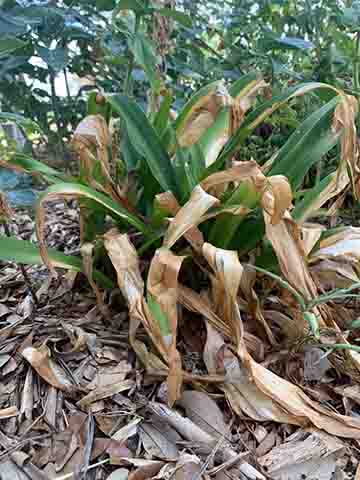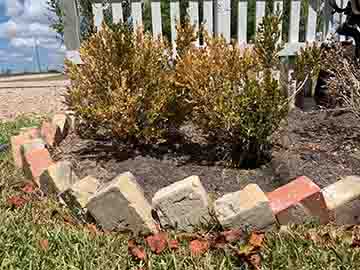Anyone who has ventured outdoors this month has to be wondering who left the doors open to the gates of hell? Summers are always a challenging time in Texas gardens, but this year has brought record heat and drought and it is only mid-summer! So, aside from moving to cooler climes how can we manage our gardens until the Aggies and Longhorns return to the field with the cooler temperatures in the fall?
Always safety first! While the second priority is our beloved plants, the first priority is caring for the gardener. We want to be sure the gardener is around to help those plants make it until autumn, so nurture the gardener first. To stay as cool as possible while gardening in summer wear loose fitting, breathable, light-colored clothing. Remember the sunscreen and/or bug repellent before heading out. Try to complete any strenuous tasks in the early morning while temperatures are at their coolest, or at the very least avoid the heat of mid-day to late afternoon. A broad-brimmed hat will help to cool your head and neck. Of course, one of the most important precautions is to stay hydrated! Drink plenty of water or none caffeinated soft drinks or juices. Avoid caffeinated and alcoholic drinks as these can be diuretics contributing to dehydration. Take frequent breaks in a shady location. Think of them as strategy breaks in planning your garden efforts. Finally, if you must be out in the extreme heat, it is a good idea to bring a garden buddy. You can keep an eye on each other’s condition, and it gives you someone to complain to about the weather!

Well now that we have preserved the gardener, what can we do to save our gardens? The obvious answer is to irrigate, but it is critical to manage how we irrigate. Water is a valuable and scarce commodity in Texas’ summers, so we want to use it wisely. Drip and low flow irrigation such as below canopy spray stakes or bubblers provide advantages. These forms of irrigation reduce evaporative losses, allow directed and differential application on an area by area or even plant by plant basis, can be hidden from view, and avoid overspray of salty irrigation water onto foliar surfaces. Remember to check your water pressure if you are using low flow irrigation and if the pressure is higher than recommended, installation of an inexpensive pressure regulator will save many headaches from blown drip lines. A light application of organic mulch over the drip lines, not more than 2 to 3 inches deep, can help reduce moisture losses from the soil, but excessive mulch applications impede water infiltration and gas exchange needed for healthy root growth in the soil.
Overhead or spray applications of water may be necessary on large turf areas. In order to reduce evaporative water losses, irrigation from these sources should be made during the morning or evening hours. Be sure to allow sufficient time for leaf surfaces to dry before dark to avoid fungal pathogens infecting the foliage. In areas with salty irrigation water it is critical to avoid contacting the foliage during irrigation. The leaves are much more sensitive to salt exposure than the roots of most plants, so subcanopy application methods will reduce the adverse impact of salty irrigation water. This also applies if a gardener is using a tertiary (recycled) irrigation source as these are often high in dissolved salts. Plants vary tremendously in their ability to tolerate salt exposure, so it is important to reserve your best quality water, such as captured rainwater, for use on the most sensitive plants.
Regardless of the application technology you choose to use, best results typically occur when we water thoroughly, but less frequently. This encourages deeper root development and helps to wash any accumulated salts out of the upper layers of the soil where most of the roots develop. Moisture monitoring devices of varied complexity are available to help with timing of irrigation, but for landscape beds, vegetable gardens, and containers, the old finger method is pretty reliable. Push your finger in the soil or pot substrate, if it is wet there is no need to water, if it is dry wet its whistle. For turf areas, look to see if footprints remain when you walk on it, a sign that the grass may need water. Efficiency of overhead spray applications can be greatly enhanced by performing an irrigation audit and making needed adjustments to risers and run times.
While we still need to monitor plant nutrient levels during heat and with frequent irrigation that can leach these minerals from the soil, it is important to avoid over application of fertilizers as they can contribute to salinity issues. Fertilizers are essentially various forms of mineral salts. Use a soil test to determine fertilizer requirements.
Plant selection and siting can be even more critical to gardening success during heat and drought periods than when more favorable conditions exist. Siting annual plantings with a bit more afternoon shade than might be needed during milder weather may help. Emergency shade can be provided to sensitive plants by erecting shade cloth over them, but be sure to avoid direct contact of the shade cloth with the foliage. Obviously using heat tolerant seasonal plants like tropicals or summer-loving annuals will be more successful than those plants typically used in more temperate landscapes. Many of our xeric Hill Country and West Texas plants can be winners in the severe heat but need to be located where soil drainage conditions are very good. Be careful of killing plants with kindness as root rots can develop quickly in over-saturated soils. This is of particular concern when balancing turfgrass needs with some of our more sensitive trees such as post oaks which can easily be overwatered.
A similar strategy of switching to heat tolerant plants can be used when cycling our vegetable crops. Plants like okra, sweet potatoes, and peppers thrive in the heat provided they have sufficient soil moisture. Vegetable gardens are ideal locations for drip and low flow irrigation uses. Be sure to monitor both landscapes and vegetable gardens for pest and disease infestations as stressed plants may be more susceptible than usual to infection and a juicy, well-watered garden is perfect for attracting various insects and predators. An added benefit to gardening through the tough summer is that you provide much needed flowers for our native pollinators and honeybees. Happy gardening and someone please remember to close that gate!
Michael A. Arnold, Professor of Landscape Horticulture and Director of The Gardens at TAMU

